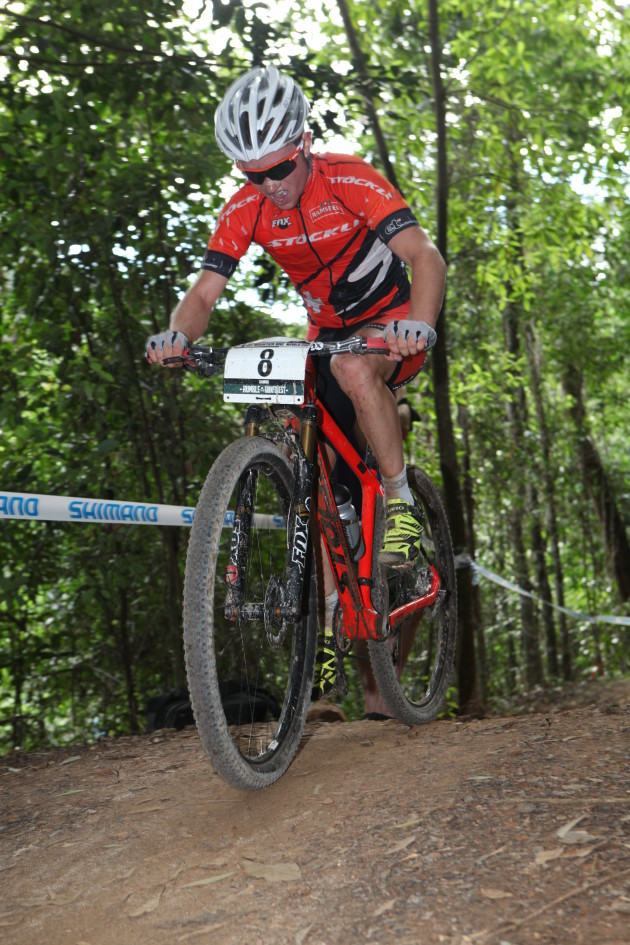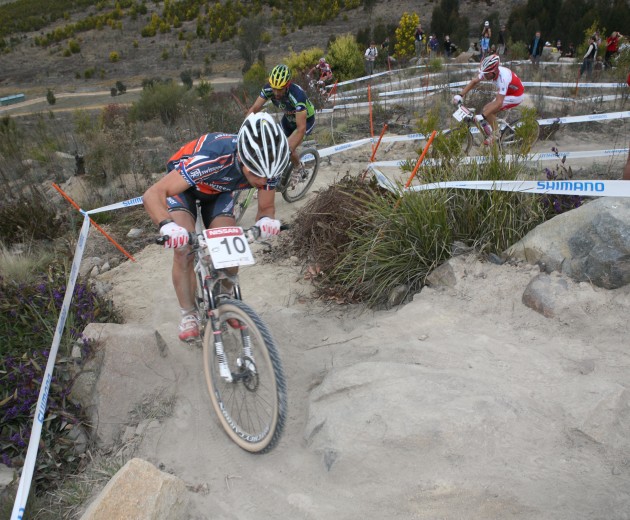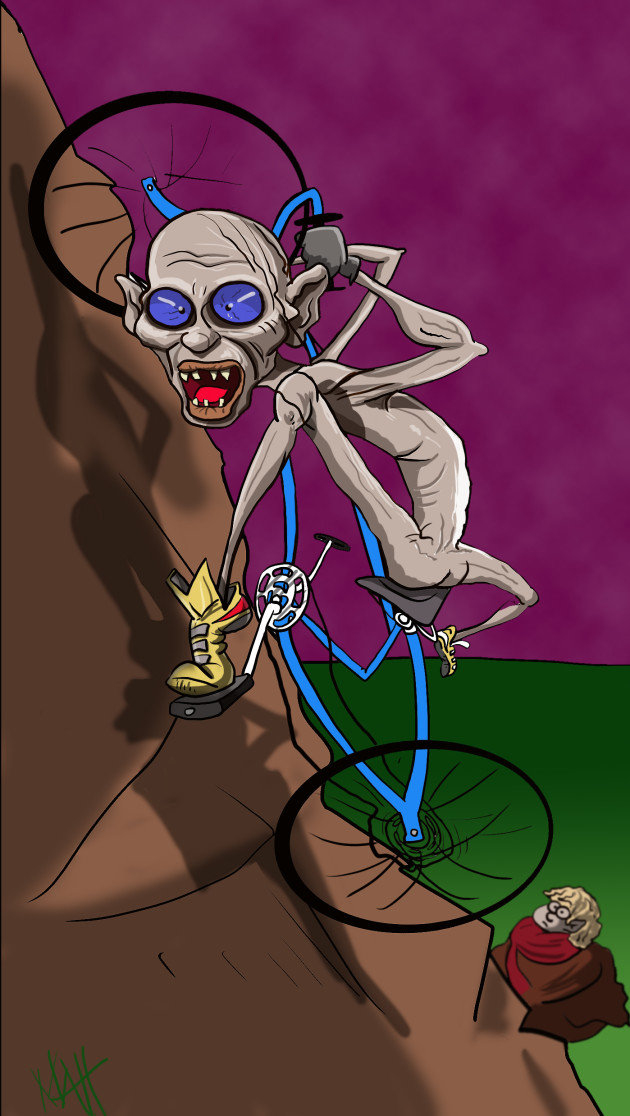Matt Hart offers his essential and somewhat unique guide on how to become a better hill climber.
When someone states that someone is ‘a good climber’ it conjures up an element of mystique and fantasy with me. What is a good climber? I have an imaged etched into the creative side of my brain; I see some kind of supernatural, lean, ripped, if not slightly unhealthy-looking character with body fat so low that you can see the blood coursing through its veins. Perhaps the closest visual specimen I could suggest would be Golum from the Lord of the Rings trilogy…
I have a vivid imagination of course, but I’m also a scientist, so a logical and intelligent set of rules comes to me just as easily and overrides these sometimes quirky fantasies. So sadly, if you were enjoying my whimsical ramblings, it has to come to an end. Being a good climber is actually just about three things:
• Your body weight
• The weight of your bike and equipment
• Your power output
If Golum did exist, perhaps he would be both powerful and light in his own mythical way, but the fella can barely stand on two legs, so the chance of him being able to power a bicycle uphill is quite frankly out of the question. I reckon his immune system would prevent him from ever realising greatness anyway, because he always seems to be coughing and sneezing when I’ve seen him.
I guess what I’m trying to say in a very protracted and odd way is that a great climber isn’t mysterious; they simply have a good power-to-weight ratio. Let’s look at the three points listed above to make sense of it all.

Body Weight
Light people go up hills faster, because they’ve got less mass to shift against gravity—it’s as simple as that. A good experiment to carry out if you think my opinion lacks credibility is to find a big hill near where you live and ride up it as fast as you can (after a sensible warm up of course) and time yourself from start to finish. Then, once you’ve recovered from your first effort, go to your local supermarket with a large backpack and fill it with cans of beer. Pay for it obviously, then ride gently to the bottom of the aforementioned hill and repeat the experiment. You should notice that you’re quite a bit slower on the second effort. If you can’t be bothered doing this exercise, although I stagger to think why you wouldn’t, you could do the same experiment in your car—it’ll work in the same manner but you’ll need to purchase a lot more beer!
So there’s a lesson here for people who want to ride up hills quicker; the less weight you carry up a hill, the faster you’re going to go. I used beer as the ballast in my example for obvious reasons, as this is one of the culprits responsible for many people carrying too much body fat in modern society. It’s not quite a linear response. Every tin of beer you drink won’t increase your bodyweight by the mass of that tin, but creeping obesity is a huge problem in the western world and if you’re consuming a few hundred calories per day that you’re not burning off, your body fat levels will sneak up (and your climbing prowess will sneak down).
Beer isn’t the only weight gain demon; there are a multitude of calorie sources that will get stored as body fat if you don’t use them. The problem is that weight loss, or the more politically correct ‘body weight management’, is made ever so complex by the multi-million dollar dieting industry. Aggressive dieting corporations will have you believe that consuming a diet of Chinese goat urine will work wonders for your figure, so long you don’t forget to ingest their special and expensive milkshake once per day whilst standing on one leg, facing north and praying to the god of slenderness. So this might be a good time to enlighten you with the ‘energy balance equation’—it goes a little like this:
- If the calories (energy) going into your body are greater than the ones being used up by your basic metabolism plus the exercise that you do, you will put on weight.
- If the calories (energy) going into your body are less than the ones being used up by your basic metabolism plus the exercise that you do, you will lose weight.
Naturally, if energy going in equals your metabolism and exercise output, your weight will stay the same.
What’s interesting is that I have studied sports science at degree level for three years, worked for 10 years in health clubs in central London and coached and consulted for a similar period of time with numerous athletes (including those at world class level), yet weight loss essentially comes down to ‘eating less and exercising more’. It’s not rocket science and it never has been, so don’t believe the hype and part with your cash for some ‘clinically proven’ weight loss solution. Their ‘proof’ was probably extracted from a university study where some heavily intoxicated post grad student was paid off to say absolutely anything, if indeed there was a study at all. If the ‘weight loss solution’ stands any chance of working, it will simply revolve around a negative energy balance, and that can be achieved without drinking goat’s urine and all the other stuff.
Beer has been mentioned a few times already in this article, so I may as well mention it again. Did you know that alcohol contains seven kcals per gram and that you have to store these calories as fat before you can release the energy? This makes it worse than dietary fat, which is more energy-rich at nine kcals per gram, because at least with the fat from your food, you’re able to metabolise it whilst it’s surging through your vascular system looking for somewhere to call home. Carbohydrate and protein are both four kcals per gram, so they have the lowest energy density out of all the nutrients, however it needs to be noted that any calorie consumed in excess of your energy output for that day will be stored as fat.
Now consider that 1kg of fat is 9,000 kcals, so if you have a positive energy balance of 500 kcals per day (which is quite easy to achieve), it will take you 18 days to put on a kilogram in body weight. By the same token, if you want to lose weight, a negative energy balance of 500 kcals per day will result in a weight loss of one kilogram in 18 days. What never ceases to amaze me is that people will allow weight to creep on at about a kilogram per month, but when it comes to losing it, they want to lose a kilo per week! The message here; if you want to lose weight and climb hills faster, take your time in losing the body fat—don’t be in such a rush and you’ll get there.
Bike & Equipment
I don’t think we need to spend too much time on this point do we? It all makes sense doesn’t it? However, before you go out and spend your inheritance on the latest XC race whippet-engineered bike to save weight, please consider the point mentioned previously. If you’re carrying a few kilos of extra lard, start by getting out on your existing bike a bit more, increasing the intensity of your exercise sessions and cut back a bit on the calories. You can then put all the money you’ve saved on food aside and buy your dream bike once you’ve reached a bodyweight where you can really do it justice.
So, what should this dream bike be? Now mountain biking has split into co-existing worlds of downhill, freeride, gravity-enduro, all-mountain and trail riding, so there’s no such thing as the perfect bike for everything. However, if you’re a cross-country or marathon rider, climbing hills quickly and efficiently is an important part of your discipline, and you will ascend at a slower rate if you ride a heavily overbuilt bike.
With a bit of practice, it’s possible to improve your bike handling and descending on a lighter bike with shorter travel—even dare I say it on a hardtail. If on the other hand you just get out in the dirt for fun or have other priorities, ride whatever leaves you grinning like a Cheshire cat.
Whatever your motivation, you’ll ride better and struggle less with a couple of kilos less around your waistline. Besides, the gains to be had on your bike are comparatively small and almost always costly.
If you really want to save some weight, consider what you carry in your backpack. Hydration packs may be great for staying hydrated whilst riding a technical trail but there’s no need to completely fill a three litre bladder if you’re heading out for a 30 minute lap in a team’s endurance event. Likewise, in competitive XC events I often see people loaded up with rather large hydration packs. It really has become a bugbear of mine and leaves me wondering what they are carrying. Do they take a full survival kit out with them or a spare fold-up bike? I really am curious. In most cases, it probably ends up being a mountain bikers’ handbag; full of random stuff that he or she might need in case they encounter a really obscure situation—bomb disposal perhaps? Slim it down a little when appropriate; just go with a water bottle on your bike, use the three pockets on the back of your jersey and fit a small saddle bag if you run out of space.

Power
Again, if we consider the ‘car being driven up a hill’ scenario, imagine completing the second test when the car is full of beer, but doing it in a different car. Imagine a car with jet engines and rockets attached to it, yet still full of beer. This contraption will ascend the hill in a fraction of the time it would take the empty car because it has significantly more power.
Apologies for the perhaps condescending example, but I mention this because I’ve lost count of the number of times that someone has said to me that they’re not a very good hill climber and that they therefore need to practice riding up hills. Whilst this may seem like the common sense thing to do – to practice the skill you’re not so good at – there’s actually not a huge amount of logic in it other than the repeated bouts of intensity will increase power over time.
I maintain that you will go significantly faster up hills if you lose some weight as previously discussed and then consider ways of increasing your power as a separate entity. That means you could train to achieve more power on the flat and then when you do reach a situation where the land tips upwards, you will, I assure you, ascend quicker than you did before.
Boosting your power is rather a broad subject though, because some of us have good short-term anaerobic power, so can ascend short hills quickly and others have a higher sustainable power, which benefits them on longer, more drawn out climbs. If you want to be a true master of hill climbing, you should work on both the aerobic and anaerobic energy systems, because this will give you the versatility to ‘snap’ and conquer a short hillock and also be able to master the longer, more tactical climb where pacing yourself will be key.
For the anaerobic snap you should work on three types of high-intensity intervals:
• 15-Second Intervals
This should involve just 15 seconds of explosive power followed by a long, three minute rest. This trains the ‘phosphocreatine energy system’ and you need the long rest between intervals to allow this energy system to regenerate itself. Cutting down the recovery between these intervals is actually a bad thing to do, so don’t rush this session. Start with six intervals and work up to as many as 20 if you can find the time.
• One Minute Intervals
These are one minute efforts with a two minute recovery between them. Pace yourself so that your power output is as even as possible throughout the interval, but by the time you’re into your last 10 seconds, it should hurt a lot! Start with four of these and work up to 10 as you get fitter.
• Two Minute Intervals
Go for two minutes with one minute of recovery between them. Again, pace yourself and try to keep an even distribution of power throughout the interval. Start with four and work up to eight repetitions over time.
The first short 15-second intervals can be combined with the second or third types in the same session, but don’t combine the second and third types. As a suggestion, choose one day per week and have a two week rotation so that you complete first and second types in week one and first and third types in week two.
Where do you perform these? Well, you could find a hill to ride up and down, there’s nothing wrong with that, but you could just as easily complete these on an indoor trainer or exercise bike and they’ll have the same power-boosting effect.
For aerobic power, or more precisely ‘anaerobic threshold power’, you need a different kind of interval. These intervals are more prolonged with shorter rest periods and here are two examples:
• Five Minute Intervals
Just as the title states, ride hard for five minutes, then go easy for one minute and repeat. Start with to two and work up to six repetitions as your fitness progresses.
• 10 Minute Intervals
These are the same as above, but the interval is longer and you are rewarded with a two minute recovery. Again, start with two and work up to four repetitions over time.
Similarly, you should perform one of these sessions once per week, preferably at least two days apart from the higher intensity interval session. Do the five minute intervals one week and the 10-minute ones the next.
So don’t be disgruntled and think that because you don’t live within cooee of a mountain you’ll never improve on your climbing ability. Apply some of these ideas and you’re bound to improve. It’ll never be easy but it really is quite simple.
So in closing, I hope that in addition to learning how to become a better hill climber, you’ve also learnt valuable lessons on why certain cast members of the Lord of the Rings will never be able to train as consistently as you, why it’s inefficient to drive your car fast up a hill when it’s loaded with beer, and how it would be useful to do a bit of housekeeping on your backpack. Who knows what you might find in there? You might even find the ring, my precious…








